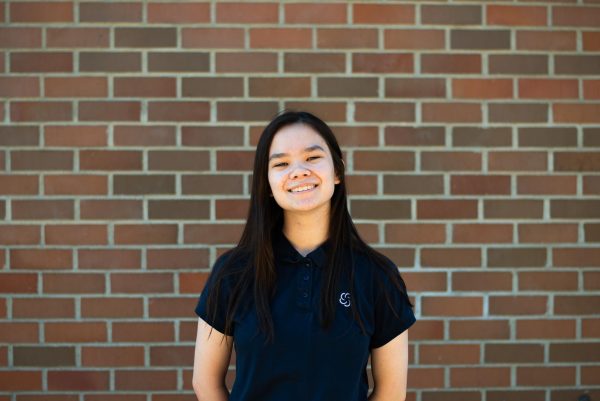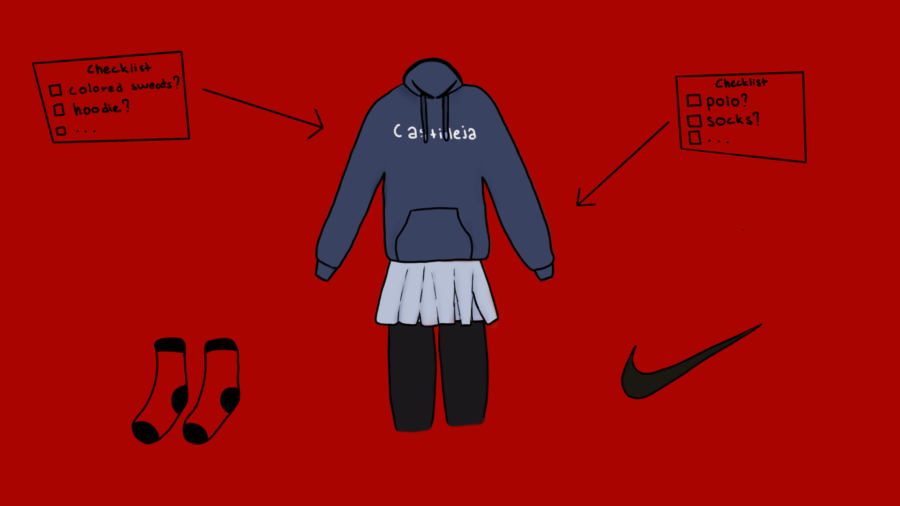Behind the scenes on uniform checks
Tanvi Prasad
Castilleja’s uniform guidelines include specifications on many minor details, such as the color of sweatpant tubing or the size of sock logos.
Most Castilleja high schoolers have become familiar with the newly implemented uniform checks before entering the Chapel for Upper School (US) Meeting. Whether you heard the announcement from your dean or received a UV yourself, these checks have become a standard part of Castilleja life. But what do these checks mean to accomplish?
According to Ms. Kulbieda, the sophomore class dean and the Upper School dean of students, these inspections are meant to remind students of the importance of the uniform. “I think there was a sentiment [among the deans] that during COVID, there was some uniform integrity lost,” said Kulbieda. “Yes, we should still allow students to wear sweatpants if it’s cold but also signal that the uniform is a really important part of our culture.”
Mr. Mayfield, the junior class dean, concurred: “There are a lot of people out of uniform one way or another based on what’s in the handbook.”
As for the reasoning of the checks being held before US meeting specifically, Mr. Mayfield explained that due to the impracticality of constantly monitoring the uniform, “we wanted to isolate a time when it was especially important for the students to be in uniform … Upper School Meeting is a good way to see everybody at the same time and keep everybody mindful that we are a community.”
Although these inspections are just on Wednesdays, Ms. Kulbieda believes that they will serve as important reminders of the uniform throughout the week: “Faculty have also been tasked with paying attention, in ways that feel comfortable to them, around [the uniform] … in a relationship-building way that’s less punitive.” She adds, “The goal is 95% compliance. There are some days where kids just run out of socks. That’s why I prefer it to be a conversation.”
In practice, though, student opinions on these checks are mixed. The experience of being UV’d at Upper School Meeting or watching one’s peers receive a UV can be unpleasant for students and create a tense atmosphere.
Citing the inherent power imbalance between a teacher and a student, Carolinda Silva ’24 expressed that even when a teacher “calls in” a student informally, it can still feel condescending: “There’s always that power dynamic that’s going to come into play.”
A student government member whose responsibilities include taking roll at Upper School Meeting echoed this sentiment: “It’s a little uncomfortable watching [my dean] police what everyone’s wearing … it’s a little weird having to watch while everyone’s getting in trouble.” They also added that due to their position, they were often treated by their classmates as an intermediary between the administration and students: “On Tuesday nights, people text me and ask me if there are going to be uniform checks because it’s going to affect what they wear.” They revealed that this role as a go-between made it difficult for them to fulfill their duties as a class officer while also maintaining their peer relationships.
For Ms. Kulbieda, the implementation of uniform checks is not to punish students but to encourage them to adhere to the uniform guidelines of their own volition. “My dream is that Castilleja students would wear their uniform as a sign of pride to be at a school that they love and a school that they’re proud of … and that it becomes less about policing and more about [the uniform] being a sign of a strong community.”
Perhaps what we need is a two-way conversation between the administration and student body—not only to communicate and clarify policies to students, but to create space for students to be heard in turn.

Michelle Leonard '24 is Counterpoint's Editor of News. She is active in the arts, co-leading Glee and performing in Castilleja’s theater productions....


